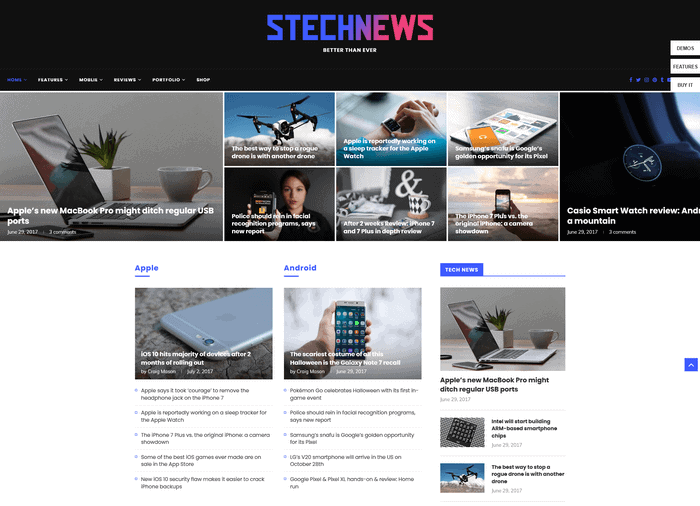How the Best tech blog Keeps You Updated on Cutting-Edge Gadgets and Software
How the Best tech blog Keeps You Updated on Cutting-Edge Gadgets and Software
Blog Article
Comprehending the Rise of Edge Computer in Today's Digital World
In the quickly evolving landscape of modern technology, edge computing becomes a pivotal force, improving just how data is refined and utilized. This paradigm change is driven by the spreading of IoT tools and a rising need for instant data handling. By transitioning information administration closer to the source, edge computer addresses critical latency issues while maximizing transmission capacity usage and improving safety and security measures. As sectors pivot in the direction of smarter, a lot more efficient systems, recognizing the nuances and implications of this technical development ends up being essential. What does this mean for future developments and the electronic ecosystem overall?
What Is Side Computer
Side computer, although a reasonably current improvement in the world of modern technology, fundamentally transforms just how information is processed and handled by bringing computation and information storage space closer to the area where it is required. Unlike typical cloud computing models, which usually depend on central information facilities that can be geographically distant, edge computer decentralizes data handling. This closeness lowers latency, boosts real-time data handling, and boosts the general user experience by making certain faster response times.
At its core, edge computing involves a network of local devices and framework, such as routers, sensors, and portals, efficient in processing information at or near the resource. This localized processing capacity is particularly crucial for applications needing immediate information evaluation, such as independent lorries, commercial automation, and smart cities. Additionally, by offloading information handling tasks from central web servers, edge computer minimizes bandwidth needs and boosts data privacy and protection, as delicate information can stay on-site instead of traversing considerable networks.

Trick Drivers of Fostering
Several elements are pushing the fostering of side computer in today's digital landscape. Among the primary vehicle drivers is the exponential boost in connected gadgets, typically described as the Internet of Points (IoT) This rise develops vast quantities of data that require to be processed promptly and successfully. Side calculating addresses this requirement by allowing information handling closer to the information resource, reducing latency and boosting real-time decision-making capacities.
An additional considerable vehicle driver is the demand for improved bandwidth performance. Centralized cloud systems can end up being overloaded with the large quantity of data produced by IoT devices, resulting in bottlenecks (Best tech blog). By refining data at the side, organizations can ease network congestion and improve total system efficiency
In addition, protection and personal privacy problems are pushing organizations toward side computer. By processing sensitive information locally, companies can mitigate risks associated with data transmission and direct exposure to potential cyber risks.
The rise of applications calling for real-time processing, such as autonomous automobiles and boosted fact, likewise demands the rapid action times that border calculating offers. Jointly, these drivers are making edge calculating an important component of modern IT framework, leading the way for its extensive adoption throughout different industries.
Benefits Over Cloud Computing
How does side computer identify itself from traditional cloud computing? Largely, edge computer brings data processing closer to the resource of data generation, commonly on nearby servers or neighborhood devices, instead than depending on centralized data.
Furthermore, edge computer Read More Here enhances transmission capacity performance (Best tech blog). By refining data in your area, only the required information is sent to the cloud for more analysis or storage space, minimizing the volume of data that traverses the network. This not only reduces network congestion yet additionally lowers information transmission prices
Edge computing also uses enhanced information personal privacy and security. Delicate data can be processed locally without being sent out to the cloud, lessening the direct exposure to prospective cyber hazards. This is especially useful for industries handling secret information, such as medical care and monetary solutions.
Moreover, side computing ensures better durability and integrity. Neighborhood processing enables for continued procedure even when connectivity to the cloud is compromised, preserving necessary features and services regardless of prospective network interruptions. These benefits collectively demonstrate side computing's transformative possibility in maximizing efficiency and protection in electronic ecological communities.
Factors To Consider and challenges
While side computer uses countless advantages, it additionally presents one-of-a-kind difficulties and factors to consider that have to be dealt with to totally understand its potential. One considerable challenge is information safety and security and privacy. Handling information better to the resource boosts the threat of unauthorized accessibility, necessitating robust encryption and rigorous safety and security continue reading this protocols to secure delicate information. Additionally, handling and checking a decentralized network of edge devices can be complicated, calling for sophisticated tools and strategies to guarantee seamless operation and maintenance.
An additional factor to consider is the scalability of edge computing options. As the number of connected devices expands, so does the demand for processing power at the edge, which can bring about source restrictions. Organizations has to very carefully plan their infrastructure to suit this development without endangering efficiency or effectiveness.
Interoperability is one more vital aspect. With various software and hardware elements included, making sure compatibility and smooth combination can be tough. Standardization initiatives are important to facilitate communication between disparate systems.
Future Patterns in Edge Computer
Anticipating the future, side computer is poised to change various sectors by making it possible for quicker data handling and reducing latency. As the quantity of information generated by IoT gadgets proceeds to expand, edge computer will certainly end up being significantly important in handling this increase effectively.
One more arising pattern is the advancement of edge-native applications made specifically to leverage the unique capabilities of edge computer. These applications will optimize efficiency and source usage, resulting in boosted efficiency throughout different industries. In addition, improvements in 5G technology will certainly further boost side computer by offering the necessary facilities for high-speed, low-latency interaction in between gadgets and edge nodes.
Conclusion
Edge computing's surge is driven by the proliferation of IoT devices and the demand for real-time information processing, which enhances effectiveness by lowering latency and decentralizing information management. This method minimizes bandwidth inadequacies and safety concerns, facilitating innovations in applications like clever cities and independent lorries. Regardless of challenges such as framework complexity and integration, the future of edge computer assures an extra responsive digital ecological community, with proceeded innovations forming its evolution and increasing its applicability throughout industries.
Side computing, although a fairly current advancement in the world of technology, essentially transforms just how information is refined and managed by bringing computation and data storage closer to the area where it is needed. Unlike traditional cloud computing versions, which typically rely on centralized data centers that can be geographically distant, edge computer decentralizes redirected here information handling. In addition, by offloading data processing tasks from central servers, edge computer minimizes data transfer requirements and improves data privacy and safety and security, as delicate info can stay on-site instead than traversing comprehensive networks.

Report this page